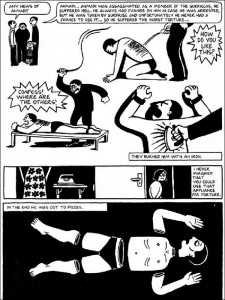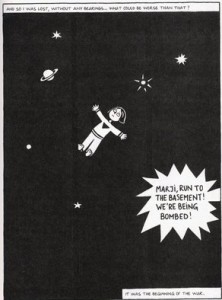Hey, every one! Recently our ASTU class are focusing on persepolis which is wirtten by Satrapi and of which the main idea can by seen on my second blog. Then we continue to read and discuss Hillary Chute’s study titled The texture of retracing in Marjane Satrapi’s percepolis, in which the author analyze the books in a feminist’s angle, extending the procedure of unfolding memory by Satrapy as well as the unique style of presenting trauma.
During the group discussion in class, some of my group members talk about the abstract way of this graphic narrative, a good example of which is the cutting body seen on the first frame in page 52  . By drawing this image from a child’s perspective, as Chute puts it, Satrapi show us that certain modes of representation depict historical trauma more effectively. To better show the normalcy of violence and trauma, Strapi further uses black-and-white style, which impose a radical contrast between the simplicy and the complicated meaning the author wanna convey. This tecnique make me think of traditional Chinese paiting.
. By drawing this image from a child’s perspective, as Chute puts it, Satrapi show us that certain modes of representation depict historical trauma more effectively. To better show the normalcy of violence and trauma, Strapi further uses black-and-white style, which impose a radical contrast between the simplicy and the complicated meaning the author wanna convey. This tecnique make me think of traditional Chinese paiting.
Although we see the Chinese traditional painting, which was conducted with brush pen and black ink, as a complete different genre to comic books, I find some similarities between them. Let’s first take a look at the little Marji floating in space after going through an overthrew of her belief and the loss of she beloved Anoosh. The single frame takes over the whole page with Marji’s tiny body in the center, around by the deep, thick blackness that can not be seen, which impose endless imagination on the reader on how crocky little Marji is without exact word to elaborating it. The best way to expose the artistic conception, as a chinese tradition, is the predomination of the appropiate blank and pureness.
The single frame takes over the whole page with Marji’s tiny body in the center, around by the deep, thick blackness that can not be seen, which impose endless imagination on the reader on how crocky little Marji is without exact word to elaborating it. The best way to expose the artistic conception, as a chinese tradition, is the predomination of the appropiate blank and pureness. As we can see from the typical traditional Chinese painting from the Song dynasty, there’s only a single fisherman on piragua located on the central frame rounded by river. Yuan Ma, who conducted this painting intentionally hide the shore and other stuff that constrain our sight to create a visual strike. The Technique that blank was left on purpose was called negative spacing leaving, which generally grew into a typical character in this genre, and which is mostly used for the sake of aloofness flowing among the paint. The contrast between the simple treak, blank and the spirit is pretty much likely to that we see in persepolis.
As we can see from the typical traditional Chinese painting from the Song dynasty, there’s only a single fisherman on piragua located on the central frame rounded by river. Yuan Ma, who conducted this painting intentionally hide the shore and other stuff that constrain our sight to create a visual strike. The Technique that blank was left on purpose was called negative spacing leaving, which generally grew into a typical character in this genre, and which is mostly used for the sake of aloofness flowing among the paint. The contrast between the simple treak, blank and the spirit is pretty much likely to that we see in persepolis.
This makes me think that-Will it be much more similarities among different genres?